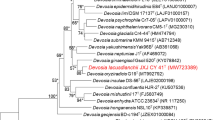Abstract
While studying the microbial diversity of hot springs of North-east India we isolated a strain AK31T from the Jakrem hot spring of Meghalaya. The strain formed light yellow colonies on nutrient agar and was Gram negative, non spore-forming rods, motile with single polar flagellum. The strain was positive for oxidase and catalase and hydrolysed starch and weakly urea. The predominant cellular fatty acids were C16:0 (34.8 %), C17:0 cyclo (27.1 %), C16:1 ω7c and/or iso-C15:0 2OH (summed feature 3) (9.6 %), C10:0 3OH (8.0 %), C12:0 (5.8 %), C14:0 (5.3 %) and C18:1 ω7c (5.3 %). Strain AK31T contained ubiquinone-8 as the major respiratory quinone and diphosphatidylglycerol, phosphatidylethanolamine, three unidentified phospholipids and one unidentified glycolipid as the polar lipids. The G + C content of the DNA of the strain AK31T was 66.7 mol%. The 16S rRNA gene sequence analysis indicated that strain AK31T was member of the genus Caldimonas and closely related to Caldimonas manganoxidans JCM 10698T and Caldimonas taiwanensis On1T with 96.9 % similarity and with Aquincola tertiaricarbonis L10T and Azohydromonas australica IAM 12664T with 96.5 and 96.4 % similarity respectively. Phylogenetic analyses indicated that the strain AK31T clustered with C. manganoxidans JCM 10698T and C. taiwanensis On1T with a phylogenetic distance of 3.25 %. Based on data from the current polyphasic study, strain AK31T is proposed as a novel species of the genus Caldimonas, for which the name Caldimonas meghalayensis sp. nov. is proposed. The type strain of C. meghalayensis is AK31T (= MTCC 11703T = JCM 18786T).



Similar content being viewed by others
References
Anil Kumar P, Srinivas TNR, Madhu S, Ruth Manorama R, Shivaji S (2010) Indibacter alkaliphilus gen. nov., sp. nov., a novel alkaliphilic bacterium isolated from haloalkaline Lonar Lake India. Int J Syst Evol Microbiol 60:721–726
Chen WM, Chang JS, Chiu CH, Chang SC, Chen WC, Jiang CM (2005) Caldimonas taiwanensis sp. nov., a amylase producing bacterium isolated from a hot spring. Syst Appl Microbiol 28:415–420
Collins MD, Pirouz T, Goodfellow M, Minnikin DE (1977) Distribution of menaquinones in Actinomycetes and Corynebacteria. J Gen Microbiol 100:221–230
Elbanna K, Lütke-Eversloh T, Van Trappen S, Mergaert J, Swings J, Steinbüchel A (2003) Schlegelella thermodepolymerans gen. nov., sp. nov., a novel thermophilic bacterium that degrades poly(3-hydroxybutyrate-co-3-mercaptopropionate). Int J Syst Evol Microbiol 53:1165–1168
Groth I, Schumann P, Rainey FA, Martin K, Schuetze B, Augsten K (1997) Demetria terragena gen. nov., sp. nov., a new genus of actinomycetes isolated from compost soil. Int J Syst Bacteriol 47:1129–1133
Kim OS, Cho YJ, Lee K, Yoon SH, Kim M, Na H, Park SC, Jeon YS, Lee JH, Yi H, Won S, Chun J (2012) Introducing EzTaxon-e: a prokaryotic 16S rRNA Gene sequence database with phylotypes that represent uncultured species. Int J Syst Evol Microbiol 62:716–721
Komagata K, Suzuki K (1987) Lipid and cell wall analysis in bacterial systematictics. Methods Microbiol 19:161–206
Kumar R, Nongkhlaw M, Acharya C, Joshi SR (2013) Uranium (U)-tolerant bacterial diversity from U ore deposit of Domiasiat in North-East India and its prospective utilisation in bioremediation. Microbes Environ 8:33–41
Lányί B (1987) Classical and rapid identification methods for medically important bacteria. Methods Microbiol 19:1–67
Marmur J (1961) A procedure for the isolation of deoxyribonucleic acid from microorganisms. J Mol Biol 3:208–218
Myers N, Mittermeier RA, Mittermeier CG, Da Fonseca GA, Kent J (2000) Biodiversity hotspots for conservation priorities. Nature 403:853–858
Ostle AG, Holt JG (1982) Nile blue A as fluorescent stain for poly-b-hydroxybutyrate. Appl Environ Microbiol 44:238–241
Siangbood H, Ramanujam P (2011) A report on thermophilic cyanophyta (Cyanobacteria) from Jakrem Hotspring, Meghalaya. Inter J Algae 13:178–185
Sly LI, Blackall LL, Kraat PC, Tian-Shen T, Sangkhobol V (1986) The use of second derivative plots for the determination of mol% guanine plus cytosine of DNA by the thermal denaturation method. J Microbiol Methods 5:139–156
Smibert RM, Krieg NR (1994) Phenotypic characterization. In: Gerhardt P, Murray RGE, Wood WA, Krieg NR (eds) Methods for general and molecular bacteriology. American Society for Microbiology, Washington, DC, pp 607–654
Stackebrandt E, Ebers J (2006) Taxonomic parameters revisited: tarnished gold standards. Microbiol To-day 33:152–155
Takeda M, Kamagata Y, Ghiorse WC, Hanada S, Koizumi J (2002) Caldimonas manganoxidans gen. nov., sp. nov., a poly(3- hydroxybutyrate)-degrading, manganese-oxidizing thermophile. Int J Syst Evol Microbiol 52:895–900
Tamura K, Peterson D, Peterson N, Stecher G, Nei M, Kumar S (2011) MEGA5: molecular evolutionary genetics analysis using maximum likelihood, evolutionary distance, and maximum parsimony methods. Mol Biol Evol 28:2731–2739
Tourova TP, Antonov AS (1987) Identification of microorganisms by rapid DNA–DNA hybridisation. Meth Microbiol 19:333–355
Vandamme P, Pot B, Gillis M, de Vos P, Kersters K, Swings J (1996) Polyphasic taxonomy, a consensus approach to bacterial systematics. Microbiol Rev 60:407–438
Acknowledgments
We thank Council of Scientific and Industrial Research (CSIR), Directors of IMTECH, Chandigarh and NIO, Goa and Department of Biotechnology, Government of India for encouragement and financial assistance. We would like to thank Mr. Deepak for his help in sequencing DNA. We thank Dr. J. Euzeby for his expert suggestion for the correct species epithet and Latin etymology, and Dr. S.R. Joshi for his help in sample collection. TNRS is thankful to project OLP1201 for providing facilities and funding respectively. RK is supported by DBT-Research Associateship Program of Department of Biotechnology. IMTECH communication number is 042/2013 and NIO contribution number is 5470.
Author information
Authors and Affiliations
Corresponding author
Additional information
The GenBank/EMBL/DDBJ accession number for the 16S rRNA gene sequence of strain AK31T is HF562216.
Electronic supplementary material
Below is the link to the electronic supplementary material.
Rights and permissions
About this article
Cite this article
Rakshak, K., Ravinder, K., Nupur et al. Caldimonas meghalayensis sp. nov., a novel thermophilic betaproteobacterium isolated from a hot spring of Meghalaya in northeast India. Antonie van Leeuwenhoek 104, 1217–1225 (2013). https://doi.org/10.1007/s10482-013-0043-x
Received:
Accepted:
Published:
Issue Date:
DOI: https://doi.org/10.1007/s10482-013-0043-x




